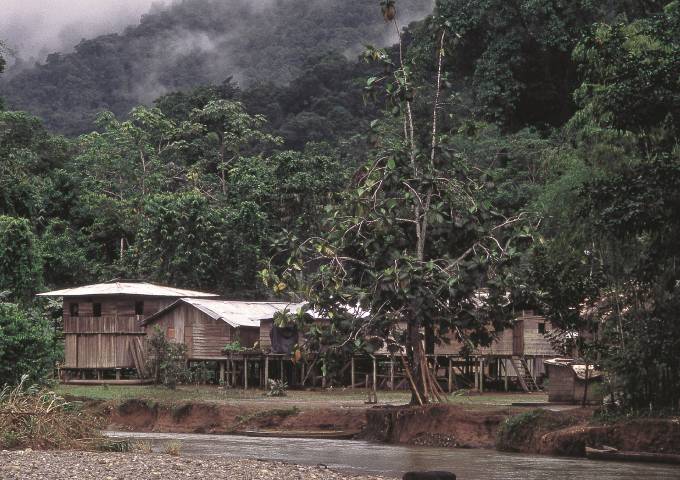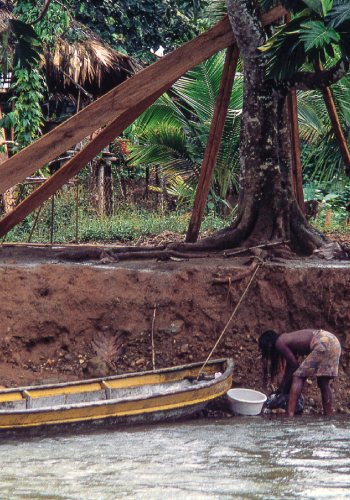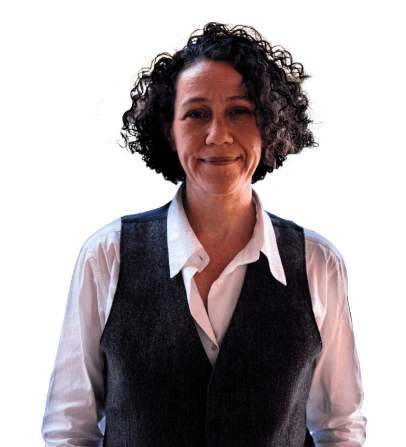A protest beyond the light
By: Inés Elvira Ospina Echandía
Photos:

By: Inés Elvira Ospina Echandía
Photos:
The Instituto Colombiano de Energía Eléctrica, Icel (Colombian Institute of Electrical Energy) granted 11 billion Colombian pesos for the construction of a small hydroelectric plant near the touristic municipality of Bahía Solano, which, despite its great natural attractions, is not connected to the power grid yet. The plant was to be built in the inlet of Utría National Park within the limits of the indigenous reservation of the Embera community of the Boroboro river, in the Mutatá ravine,” states an article published in the newspaper El Tiempo, on August 3, 1996.
This way, the renowned national media proclaimed the arrival of electricity to some municipalities of Chocó. What the newspaper did not register was that a year earlier, contrary to collective imagination, the indigenous Embera community in the area had joined the protest of their Afro-descended neighbors for the construction of the hydroelectric plant, which involved one of their sacred places: The Mutatá waterfall.
“I was defining my thesis work. My initial approach was ecotourism; however, being there, I began to move toward natural resource management in the area, and thus, I came to focus on the history of the hydroelectric plant,” recalls Nicolás Acosta García, who has a doctorate in Cultural Anthropology from the University of Oulu, Finland, and is now a researcher at the University of Gothenburg, Sweden. With his doctoral thesis, he sought to dive deep into the reasons for which the Embera community joined the protest for the construction of the hydroelectric plant.
“We were looking for a way to listen to the Embera’s voice, and we found something that was not expected: The indigenous community protested for a hydroelectric plant that they knew would deteriorate their environment. That is one of the most salient points of this research. In general, one tends to have the preconception that indigenous communities are the defenders of nature, its guardians; however, it really is a romantic, paternalistic description that tries to take away their own voice,” explains Katharine N. Farrell, professor, Faculty of Natural Sciences, Universidad del Rosario, and and one of the directors of the doctoral thesis of Acosta García.
Then, starting with that idea, the researchers directed the study toward the motivations and expectations anticipated by the protests. They posited that the social mobilization of the Afro-descendent community in favor of development is part of the continued fight for their social and political participation. In addition, the Embera’s participation, besides being an act of solidarity with their Afro-descended relatives, was a manifestation of what Herbert Marcuse has called “refusal” practiced by the “meta-industrial subject,” a social concept developed by Ariel Salleh, ecofeminist and student of Marcuse's work.
“Salleh's concept of the meta-industrial subject has its origin in how humans relate to technology and to the industrialized and modern world: The meta-industrial subject is not dependent on modern technology for their livelihood. This invites us to rethink how human well-being is created, through the use of natural resources, based on our ethical and material relationships with what surrounds us,” says Farrell, an expert in ecological economics.
Considering what was stated by the philosopher and sociologist of the Frankfurt School, the study uses the case to show how historical structures, dating back to colonial times, not only continue to permeate and shape the future of both communities but also influence how they can raise their voices to be heard in the capital of the country. That is to say, these longlasting colonial structures influence how local communities, Afro-descendent peoples and indigenous peoples, get involved and reject development projects of the contemporary Colombian state.
The origin of the protest
The Alto Río Valle and Boroboro Reserve are located in the southern part of the coastal municipality of Bahía Solano, in Chocó, to the east of the foothills of the Baudo highlands, a place where more than 700 members of the Embera community live. In 1995, the need for a connection to the power grid, driven largely by tourism, led the Afro-descended population from Bahía Solano to demand a solution.
To generate greater resonance in the protest, the Afro-descended communities invited the Embera to add their voice because the hydroelectric plant would be built on a site that is cosmologically important to the indigenous community: The Mutatá waterfall. This, they informed the Embera, was not within the reserve, and therefore, the authorities did not need permission to use the land.
This is precisely the reason why some members of the Embera community, who were not particularly concerned about ensuring access to electricity, decided to participate in the protest of the Afro-descended community, after learning that they did not have legal rights to control what would happen with the waterfall.

For the researchers, the incorporation of the Embera in the protest can be interpreted as an act of rejection of authority, one that had denied them sovereignty over the waterfall. “Marcuse’s concept of Refusal, understood as the only remaining resource to reject the totalizing oppression of technology as ideology, enables us to interpret the Embera’s apparently self-defeating position as an assertion of sovereignty. Although they had lost the ability to determine the purpose for which the waterfall should be used, they could still exercise a form of sovereignty over its disposition by refusing to allow the State to renege on its obligations to their Afro-descendant brothers and sisters,” can be read in the research work.
Construction of the Microelectric Power Plant of Mutatá, which occupies 30 ha of jungle, several of which are in the Embera’s ancestral territory began in 1998. Since the start, the power generated has been sold through the Grupo Empresarial del Pacífico S.A, Gepsa (Pacific Business Group) to the inhabitants of the municipality of Bahía Solano, and it has been provided free of charge to the indigenous community.
It is not fair to assume that indigenous people must be the guardians of the environment
A second protest that was analyzed by the research was carried out in 2009. Then, the same communities demanded the repair of the infrastructure after a landslide left the hydroelectric plant out of service for a year.
When Acosta García arrived in Boroboro in 2015, he found mistrust sparked by decades of unfulfilled promises and absence of dialog." They have a great deal of distrust because, for example, part of the tourist attraction was to bring visitors to their communities, without prior dialog, and they felt exposed,” explains the anthropologist.
Being in the Valley, and after days of patience and work, Acosta García managed to contact the community. For three hours, he traveled through the crystal-clear waters in a motorized canoe to the town of Boroboro, where he was greeted with a refusal by the Embera community. "There was no further explanation beyond that they were not interested in talking to me. I returned to the Valley, and sometime later, they introduced me to a member of the Embera community, who contacted me for a second time and suggested that I send a letter. After a few days of uncertainty, they allowed me to return and gave me hope that they would think about it. They told me to come back in a year. A year! Thus, under their conditions, I managed to start working with them,” says the researcher.

“In general, one tends to have the preconception that indigenous communities are the defenders of nature, its guardians, but, it really is a romantic, paternalistic description that takes away their own voice,” explains Katharine N. Farrell, professor, Faculty of Natural Sciences, Universidad del Rosario.
“They are going to look at your soul. If they see that you are going to respect their dignity, that you work respectfully and collaboratively, they will tell you their story,” Farrell said when she heard the response from the Embera. “Getting in was very important. It is not easy even for those working in the territory. It was achieved by taking care of the dignity of the communities. If we communicate with them in solidarity, with all the actors recognized as meta-industrial subjects, there is a greater understanding. That is what Nicolás did,” recalls the professor with a Ph.D. in Politics.
In the 2 years of field research, 38 interviews were conducted with 56 people between the two communities, Afro- descendent and Embera, sometimes in groups but mainly individually. Also, information was collected through participatory observation, field notes were taken, and informal conversations with members of both communities were considered. With all this information in hand, Farrell and Acosta García met in Berlin (Germany) thanks to an Erasmus+ scholarship (Action Plan of the European Community for University Student Mobility) awarded to the latter, and that allowed them to work together on the study.
"One of the most valuable things is that we managed to contribute, with our suggested explanation of the Embera community’s behavior, an interpretation that does not force the community to be seen as ‘guardian of the environment’ but also breaks the mold of the ‘modernized indigenous'. We constructed a description of the Embera´s behavior that frees them from having to fit into either one of these categories, both products of the colonizer's perspective,” affirms Farrell.
For Acosta García, the important thing is the contribution to the debate around multiculturalism and development. "This can be exemplified with the situation of COVID-19: Quick solutions are sought to very complex problems, but it cannot be believed that science has magical solutions. Our idea is to contribute to the debate with data to understand reality better, not arriving to an exact conclusion of how to work or in which way,” he says.

For Nicolás Acosta García, researcher, University of Gothenburg, Sweden, the important thing is the contribution to the debate regarding multiculturalism and development.